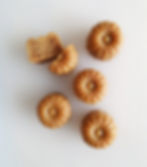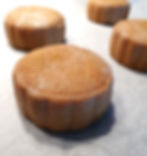Caramel Lotus Moon Cake
- Christean N.
- Sep 15, 2020
- 4 min read
Updated: Sep 2, 2021







RECIPE
Yield: (5 x 110 g Medium Moon Cakes), or
(11- 12 x 60 g Mini Moon Cakes)
Lotus Fillings
85 g Dried Lotus Seeds
175 g water
55 g Dark Brown Sugar
75 g Sunflower Oil
Moon Cake Pastry
90 g Golden Syrup
50 ml Sunflower Oil
1 tsp Alkaline Water
165 g Plain Flour
Method
For the Lotus Fillings
Before proceeding, place the lotus seeds into a deep bowl and fill with water with at least 5 cm above the lotus seeds and leave to soak overnight or for at least 4 hours. The seeds will starts to absorb the water and soften.
1. Once the lotus seeds are softened, strain off the water. Split the seeds to remove the hearts (the hearts leaves a bitter taste, so you don't want them to be in your paste).
Fill water into a pot with the softened lotus seeds ensuring that the water is above the level of the lotus seeds. Bring it over the stove to boil at medium heat for around 15 to 20 minutes. The lotus seeds at this point should be soft but still able to hold its shape. Refill with hot water if necessary.
2. Strain off the boiling water and leave the seeds to cool completely.
3. Transfer the cooled lotus seeds and icing sugar into a food processor , gradually stream in the water and blend until it is smooth. Once all the ingredients have been incorporated, leave the lotus seeds to continue processing until nice and smooth. This process took me roughly around 2 to 3 minutes.
4. Meanwhile, place the brown sugar into a non deep frying pan and bring to a melt. Pour the liquid lotus paste mix over the melted brown sugar over low heat and with a rubber spatula and keep stirring the the watery mix. As the mix starts to thicken a little as the water starts to evaporate, add in the oil in intervals while stirring , adding a little oil at a time while stirring. Make sure that the paste has fully absorbed the oil before adding more.
The mix will start to turn into a thick consistency. Keep occasionally flipping the paste the bottom on to the top until it thickens and start to turn in to a deep golden yellow colour.
To know when it is ready, the filling will starts to thicken and have the consistency of being able to be rolled in to a ball as well as a light caramel colour. Do not over cook the paste as they can become crumbly. Just as you are able to fold them on top of each other without it spreading too much, it is ready.
5. Turn off the heat and transfer the paste onto a heat proof cling film, tightly wrap and leave to cool completely in the fridge.
Lotus paste can be prepared a day ahead.
6. Once cooled, for the medium size moon cakes, divide the fillings in to 5 x 50 g and roll them in to individual balls. Set aside, covered until ready to use. (Note: For small moon cakes, I divided the fillings in to 12 x 30 g fillings - depending on how much you cook out your filling, the end quantity can vary)
For the Moon Cake Pastry
7. To make the alkaline water, boil 50 ml of water and whisk in 1 g / 1/4 teaspoon of baking powder. You only need one teaspoon of the alkaline water. (Note: Alkaline water is added to help neutralize the acid in the golden syrup that can make the skin turn sour in taste over time)
8. Place the golden syrup, alkaline water and oil together in a bowl and whisk until well incorporated. Then add in the flour and with a spatula gently mix then press and fold the mix until they form in to a dough.
9. If you are rolling the dough later, make sure that you wrap the dough with a cling film to prevent it from drying out.
10. For medium size moon cakes, portion the dough in to 6 x 75 g portion and roll them in to individual ball, set aside covered with cling film until ready to use. (Note: For mini moon cakes, I divide the dough in to 12 x 30 g individual balls)
Assembling and Baking
11. With the help of both palm, gently press from the centre outwards to flatten it to a size slightly larger than your palm (female palm though). Then place the ball of lotus filling in the centre, wrap the dough all around the filling. With one palm rounding the moon cake, gently push the dough upwards until the ends meet then pinch the dough to fully seal the filling.
12. Roll the filled moon cake with both your palm in to a smooth ball then roll it on to some flour, removing the excess flour by rolling the moon cake with both your palms again. Press the moon cake in to the mould, tilt it over then press and release.
Clean off the edges of the moon cake by pressing the excess dough at the bottom edges inwards slightly. Repeat the process for all moon cakes.
13. Place the moon cake on to a baking tray lined with baking paper, spray some water on the moon cake to prevent it from cracking then bake in the oven at 160 °C for 5 minutes. Remove the tray of moon cake from the oven and leave at room temperature until completely cooled.
14. Once the moon cake have completely cooled, brush the top lightly with egg wash. Be careful not to drench the top with too much egg wash other side you can lose some of the patterns.
15. Bake in the reduced heat oven for around 15 to 20 minutes or until light golden brown in colour. Do not be tempted to over bake.
Once the moon cakes are ready, leave it out to completely cool. Store in air tight container. Fresh moon cake will look dry coming out from the oven and need to be aged for at least 3 days before serving. During the ageing period, the oil in the filling will start to get absorbed by the skin.
Storage and Shelf Life
If you are not consuming the moon cakes immediately, store them in an air tight container in the fridge.
Aged moon cake can last up to 3 weeks in the fridge and around 1 week at room temperature

